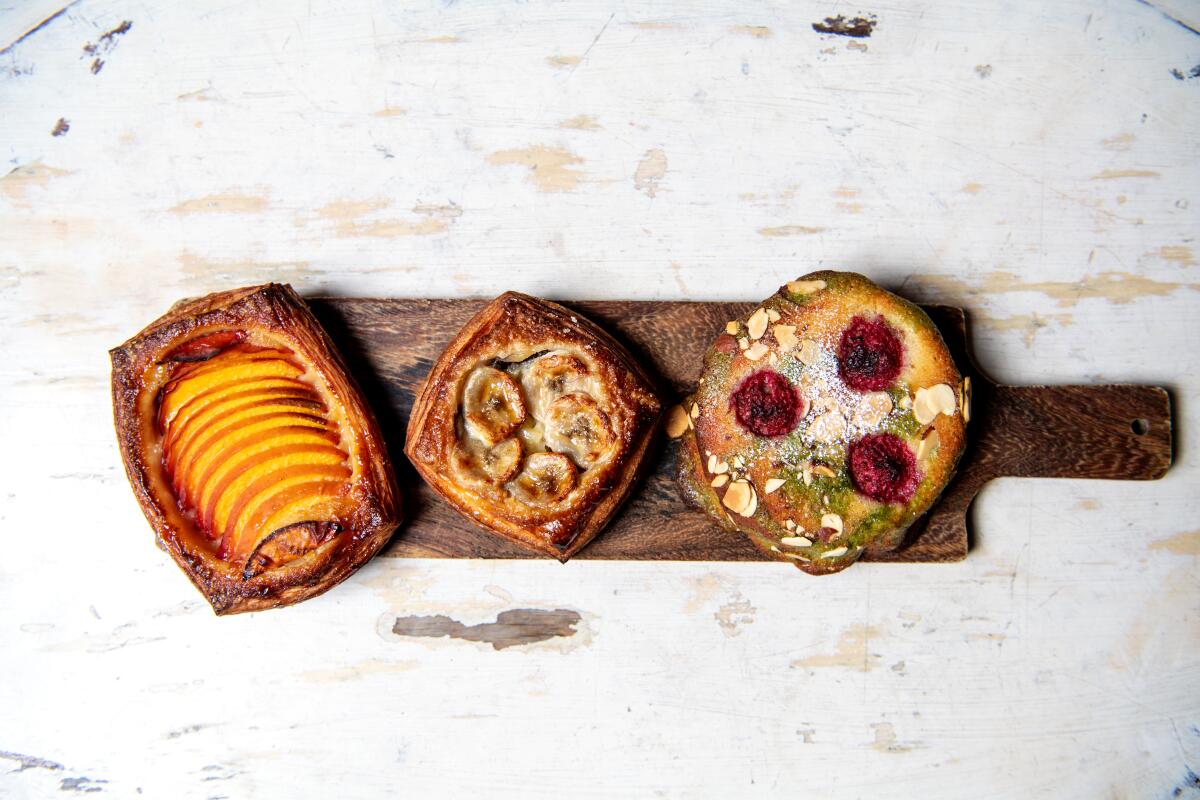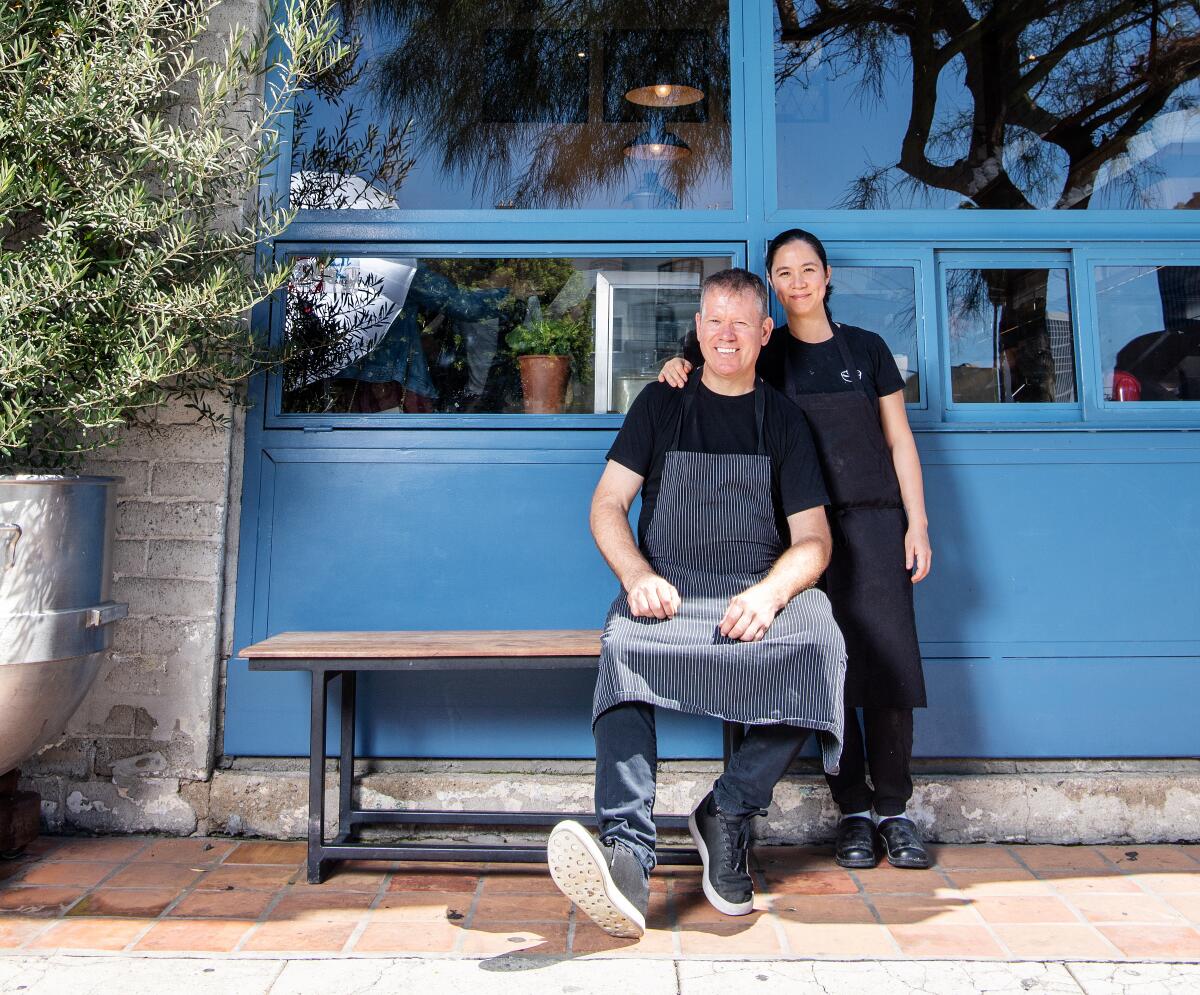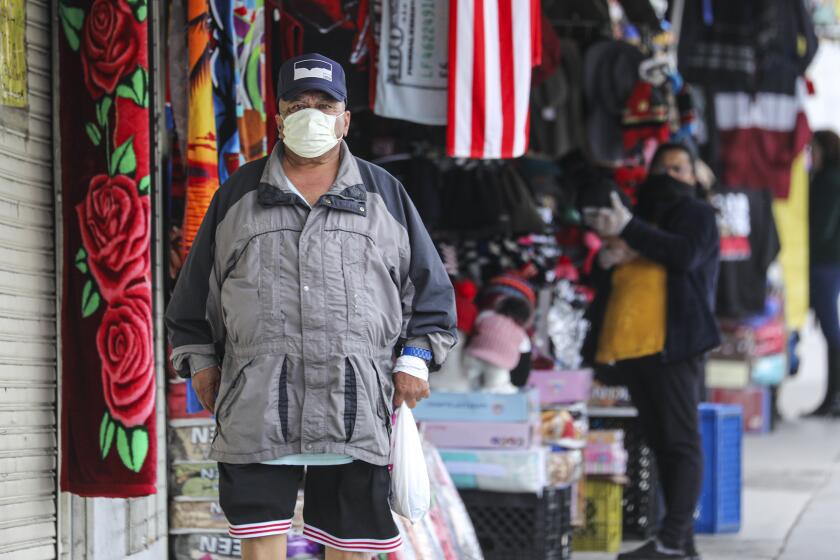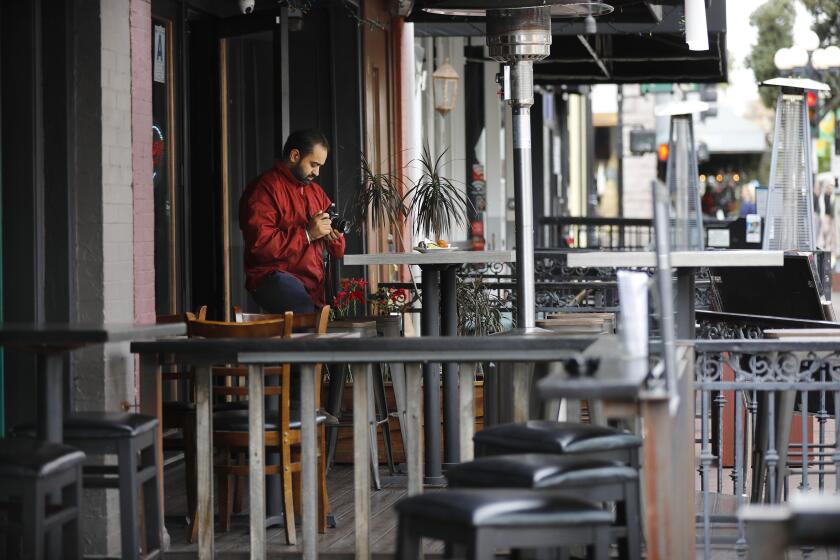A critic and a restaurant face the pandemic over pastries (6 feet apart)

- Share via
On Monday morning République, the all-day restaurant in Hancock Park, announced on Instagram it would be open to serve pastries and coffee from its takeout window. Later in the week its survival strategy would come to include pastas and rotisserie chicken dinners for delivery or takeout, but it began by focusing on viennoiserie.
Without much deliberation, I headed over.
In the car I questioned myself. The public is being urged to stay home as the most effective means of curtailing the spread of the novel coronavirus; the national death toll continues to mount. How irresponsible was it to be out of my apartment to grab breakfast? Was it worth the risk to support a restaurant I’ve praised as a critic, and where I’ve lingered over many off-duty meals?
A thin, nervous crowd milled on the sidewalk in front of the takeout window; some customers were practicing social distancing more diligently than others. Pastry chef Margarita Manzke, who owns République with her husband, Walter, greeted regulars with a wave from behind glass. Keeping 6 feet between us, I chatted with a lawyer in her 70s named Jill who stops by daily for a latte. The restaurant was only serving drip coffee but Manzke made a latte special for her.

Staffers wore masks. They handled croissants and credit cards with gloves, shedding second skins with every new transaction. The shapes of the pastries alone brought comfort: chicken tikka masala hand pies formed in flaky half-moons; oblong Danishes filled with fans of caramelized apple slices; a small round tart heavy with custard and inky berries. I bought too many and tipped generously.
Grasping the pandemic’s direness has been difficult for me. I didn’t want to believe the extent of the danger. Three weeks ago I was urging readers to go try new restaurants in the San Gabriel Valley. At this moment, in mid-March, shelter-in-place lockdowns seem inevitable. I had a review about the Ricans, a pop-up that specializes in mofongo (including at the weekly Smorgasburg L.A. festival, which is on hiatus) ready to run.
Get the latest coronavirus updates from our staff in California and around the world.
I hate the sense of powerlessness, watching the small businesses I write about — the seats of community and hospitality in L.A. — struggle on the brink of financial devastation. Some, probably many, won’t make it back without government help or intervention that needs to arrive quickly.
Something about the mix of fear and friendliness in the eyes of one of République’s staffers stirred memories of my own experience in the restaurant industry. I worked in kitchens through much of my 20s. This was the 1990s. Health insurance and paid sick leave were faraway concepts. At my highest pay I made $12 an hour. Looking back, I can acknowledge privilege: I could have returned to my parents’ house to regroup if things turned truly grim. Barring that, I scraped together rent and inched slowly into credit card debt.
Gazing at Manzke’s spread of pastries reminded me of one indie restaurant in particular where I worked, a long-closed place in Seattle called Plenty. In addition to a full-service menu we staged a deli case with photo-ready displays of prepared foods and desserts. In my corner of the kitchen, I iced chocolate cakes, whipped meringues, layered fruit crisps, stirred batters and doughs for muffins and scones, and baked the oversize cookies we sold by the register. I flipped omelets and reheated roasted potatoes to order on Sunday mornings.
What if COVID-19 had arrived in 1997? How would Plenty’s owners have mobilized to endure? Would we have stapled black-and-white copies of the carry-out menu on telephone poles around the neighborhood? Taken orders by the phone — did we even have call waiting? — and trotted out food curbside? Would we have sold the staff T-shirts embossed with the Plenty logo of a bird chirping “Amen?” Would we have urged people to buy gift certificates for the restaurant, knowing they might never be able to use them?

What would have happened if the money coming in from takeout wasn’t enough to make payroll? Would I have worked a while for free, to keep my loner self from total isolation? Would I have joined protests from quarantine, writing to congresspeople to implore them to eliminate payroll taxes and defer rents while providing other government aid like paid sick leave?
That’s what the restaurant industry faces in 2020: queries with no answers in a state of emergency. There will be unknowns for months.
I called Jim Watkins, the chef and co-owner of Plenty all those years ago (he’s since retired from the restaurant business), and asked him how he would handle the situation now.
“Yes, all those things,” he said, when I read him the above questions. “And I would hound government leaders to convince them how slim-margined and under-represented the restaurant industry is.”
As we spoke of the Plenty era, our conversation turned to the crisis that haunted us then: the AIDS epidemic. We were both close to restaurant workers who died. Without diminishing the catastrophe we lived through, the wider corollary is the cultural loss. We lost an entire generation of talent to that plague; we can’t conceive of the art, the music, the technology and the cuisines that might exist had the stricken survived.
Restaurants have been blindsided by the coronavirus pandemic. Here is a guide to services available to those affected, including financial and legal aid.
What will we lose in this disaster? Restaurants give our lives more meaning than ever. We frequent them as much for fellowship and provocation as for sustenance. Much of the professional cooking in our city involves personal narrative; chefs show us who they are and we know ourselves better. Tlayudas, galbi jjim, koobideh kebabs, khao soi, tagliatelle, spicy beef noodle soup, edomae sushi, even grain bowls and elaborate avocado toast: Food kneads together the city’s identity; the people who prepare it for us, without customers to feed, are imperiled. Not every business will successfully pivot to takeout. Not every building happens to have a preexisting carryout window like République.
As a young, broke cook I would have looked to my bosses for assurance. I didn’t have easily transferable skills. If I’d been furloughed, if the owners had bled the bank account empty, I’d likely have not known how or where to ask for help. It’s a different world, but digital connectivity doesn’t always dispel isolation. Our most visible chefs have taken to social media to urge mayors, governors and representatives to action; there are pleas for economic relief, including cancellations or delays of sales and use taxes. Who has already slipped into invisibility? How many dishwashers, servers and cooks are already wondering how they will earn their next paycheck — or are already asking where they will earn it?
It is raining in Los Angeles. I order smoked mozzarella sticks and a calzone from Cosa Buona in Echo Park. As instructed, the courier knocks on the door and then leaves the bag on the stoop for me to retrieve. I eat the meal in solitude and go back to scrolling through social media, waiting to see what happens next.
More to Read
Eat your way across L.A.
Get our weekly Tasting Notes newsletter for reviews, news and more.
You may occasionally receive promotional content from the Los Angeles Times.












